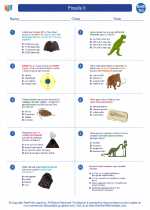Sediments
Sediments are solid particles that are transported and deposited by wind, water, or ice, and are ultimately derived from the weathering and erosion of pre-existing rocks. They can be classified based on their size, composition, and origin, and play a critical role in the formation of sedimentary rocks.
Types of Sediments:
- Clay: Fine-grained particles (< 0.002 mm) that feel smooth and sticky when wet, and can form clay minerals.
- Silt: Medium-sized particles (0.002 - 0.063 mm) that feel smooth and powdery, and are often found in sedimentary rocks like shale.
- Sand: Coarse-grained particles (0.063 - 2 mm) that feel gritty and are often composed of quartz, feldspar, and other minerals.
- Gravel: Larger particles (> 2 mm) that include pebbles, cobbles, and boulders, and are commonly found in conglomerate and breccia rocks.
Formation of Sediments:
Sediments are formed through the process of weathering and erosion, which involves the breakdown and transportation of rocks by physical, chemical, and biological processes. This can result in the formation of different types of sediments, such as sand, silt, and clay, depending on the size and composition of the parent rocks.
Importance of Sediments:
Sediments are important in understanding Earth's history, as they contain valuable information about past environments, climate, and life forms. They also provide valuable resources such as oil, gas, and minerals, and serve as the building blocks for sedimentary rocks, which make up a significant portion of Earth's crust.
Study Guide:
When studying sediments, it's important to understand the processes of weathering and erosion, as well as the various types and characteristics of sediments. Make sure to familiarize yourself with the different sizes and compositions of clay, silt, sand, and gravel, and their role in the formation of sedimentary rocks. Additionally, explore the significance of sediments in geological and environmental studies, and how they contribute to our understanding of Earth's history and natural resources.
Practice identifying and classifying sediments based on their physical properties, and consider conducting field or laboratory experiments to observe the processes of sediment formation and deposition. Lastly, make connections between sediments and other Earth systems, such as the rock cycle, water cycle, and climate dynamics, to gain a comprehensive understanding of their role in shaping the Earth's surface and environment.
.


